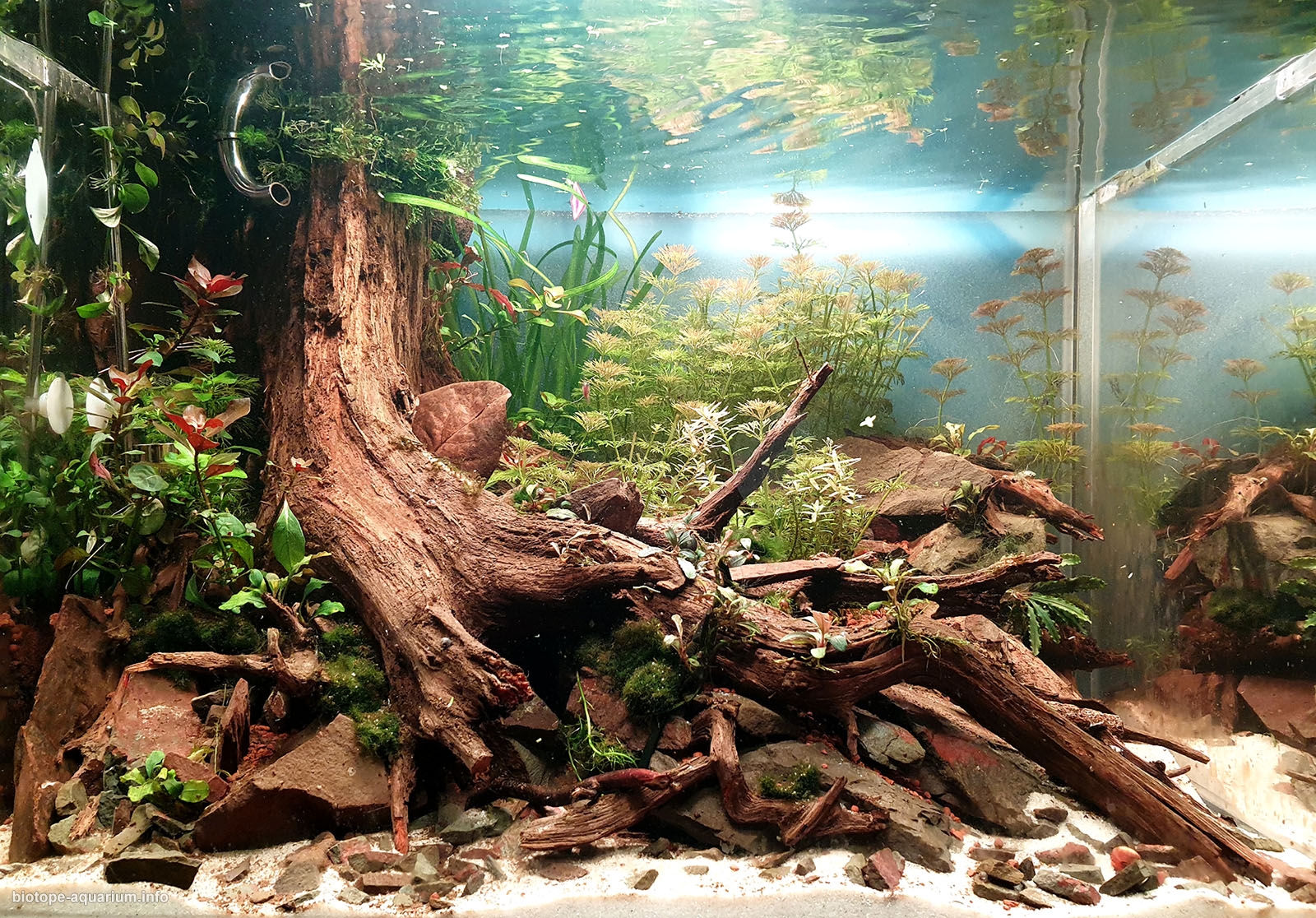Back to the Roots Myanmar Lake Inle
_th place in Biotope Aquarium Design Contest 2020

Volume: 120 L
Dimensions: 60x50x40 cm
List of fishes: Danio margeritatus, Planorbarius corneus
List of plants: Limnophila sessiliflora, Ludwigia repens, Bucephalandra Kedang, Aegagropila linnaei
Description of decorations: Riversand forground, Dupla Ground and Hobby Natalit for the Plants in the Background.
Beech root , Stones (Grauwacken).
Description of equipment: External Filter Eheim Ecco 300, Heater Dupla Heat up 100 Watt, Light 2 x Dupla Nano Lux 18 Watt, 5100 K, 843 Lumen, Dupla Co² Set 250, Hobby Hygro System.
Water parameters: Temperature 22°Celsius, ph 7.5, Kh 8, no² 0.0, Fe 0.1, No³ 0.5
INFORMATION ABOUT BIOTOPE
Description of the area surrounding the biotope: Inle is a small town on Upper Inle Lake Inle is 22 kilometers long, 10 kilometers wide and only 3 meters deep, after Lake Indawgyi, the second largest lake in Myanmar and is located in the eastern part of the country, surrounded by up to 2000Meter high Shan Mountains.a wide belt of reeds lines the freshwater lake. The approximately 70,000 people who live in 17 villages in stilt houses around the lake call themselves “Intha”, which translates as “children of the lake”. they live mainly from handicrafts, or are fishermen and farmers.
The floating gardens and the one-legged rowers are unique.
This special leg rowing technique can only be found at Inle Lake. with this technique it is possible to maneuver through the narrow channels.
The fishermen stand with one leg on the narrow bottom of the canoe and skilfully loop the other foot around the oar, which they move while standing.
so you have both hands free to fish.Inle Lake is best known for the large number of water birds, migratory birds and the floating farms on the lake.
255 forest birds, 90 wet birds, 59 fish species, 3 turtle species, 94 butterfly species, 25 amphibian and reptile species as well as several plant species, including 184 orchid and 12 algae species, are recorded in this nature reserve. A subspecies of the globally endangered Sarus crane also occurs in this area. Visitors can observe many aquatic plants and animals here.
Detailed information about the fish fauna in and around the lake is still partly unknown.
Description of the underwater landscape of the biotope: The lake is fed by poor, sweet and acidic water that has passed through peat bogs while the lake basement is limestone.
Description of the parameters of the habitat: PH stabilized between 7 and 8,The temperature move between 18 / 20°c in winter and 27 / 28°c in summer.
List of fishes and invertebrates occurring in the nature biotope: Esomus danrica
Inlecypris auropurpureus, Microrasbora rubescens, Garra gravelyi, Gymnostomus horai, Labeo rohita, Pethia stoliczkana, Puntius sophore, Puntius cf. sophore, Systomus cf. rubripinnis, Systomus compressiformis, Barbonymus gonionotus, Cyprinus intha, Cyprinus rubrofuscus, Neolissochilus nigrovittatus, Ctenopharyngodon idella, Poropuntius schanicus, Sawbwa resplendens, Anabas testudineus, Channa harcourtbutleri, Channa striata, Trichogaster labiosa, Trichopodus pectoralis, Oreochromis niloticus, Parambassis lalam Parambassis ranga, Glossogobius cf. giuris, Lepidocephalichthys berdmorei, Petruichthys brevis, Physoschistura rivulicola, Physoschistura shanensis
List of plants found in the nature biotope: Adiantum edgeworthii
Aldrovanda vesiculosa
Alisma plantago-aquatica
Ammannia baccifera
Arundinella decempedalis
Azolla pinnata
Cephalanthus occidentalis
Ceratophyllum demersum
Cladium mariscus jamaicense
Colocasia esculenta
Cyperus cyperoïdes
Cyperus digitatus
Cyperus sp. « Sha-pya »
Dichrocephala integrifolia
Echinochloa crus-pavonis
Eclipta alba
Elephantopus spicatus
Eryngium foetidum
Eriocaulon quinquangulare
Eichhornia crassipes
Elodea canadensis
Fimbristylis aestivalis
Fimbristylis dichotoma
Gahnia javanica
Hippuris vulgaris
Hedychium coronarium
Hydrilla verticillata
Hydrocotyle
Hygrophila auriculata
Hypericum japonicum
Ipomoea aquatica
Lasia spinosa
Lemna minor
Lemna trisulca
Machaerina sp. « Sha-lone »
Limnophila indica
Ludwigia octovalvis
Ludwigia repens
Lythrum salicaria
Mariscus cyperoides
Monochoria hastata
Monochoria vaginalis
Myriophyllum verticillatum
Najas graminea
Najas tenuis
Nelumbo nucifera
Nitella flexilis
Nymphaea nouchali
Nymphaea pubescens
Nymphoïdes hydrophylla
Nymphoides indica
Ottelia alismoides
Phragmites communis
Phragmites karka
Phyla nodiflora
Plantago major
Polygonum aviculare
Polygonum plebeium
Potamogeton alpinus
Potamogeton crispus
Potamogeton lucens
Potamogeton nodosus
Potamogeton obtusifolius
Potamogeton perfoliatus
Rotala rotundifolia
Ruppia maritima
Sagittaria sagittifolia
Sagittaria trifolia
Salix tetrasperma
Threats to the ecology: The Inlesee is threatened by overfishing, deforestation of the bank, pesticides, chemicals and sediments.
that’s why I am particularly fond of the danio margeritatus, because it was thought that they only live in a small pond and that they were quickly protected after their discovery .for me they are a sign that we do not yet know everything and that things are being destroyed on our planet that perhaps a person has never seen.
Sources of information: –
